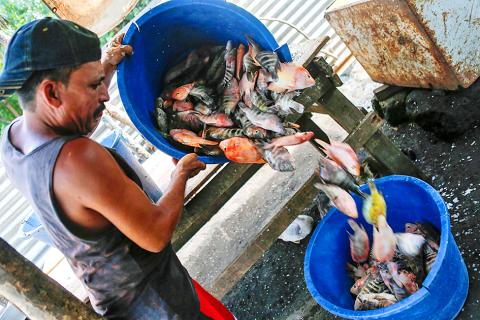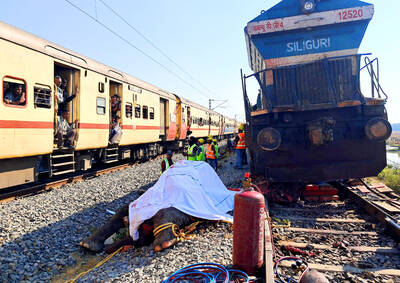Looking tired and haggard, William Coronado pulls up before dawn with a boat full of fish on the muddy shore of Nicaragua’s Lake Managua, a dumping ground for trash and waste.
“The lake is so polluted. They throw all sorts of crap into it,” the 56-year-old said. “Containers, old buckets, all sorts of bags — all the junk they throw away in Managua. It’s a disgrace.”
Coronado spent two days under the Central American sun and windy nights to bring in a haul of hundreds of tiny two-banded sea bream and other freshwater fish, to sell them for US$1.30 per dozen to a business just north of the capital, Managua.

Photo: AFP
His wife, Rosa, waits for him in a rickety house built of tin and plastic located just 300m from the lake, living in extreme poverty like most of the neighbors.
Lake Managua, also known as Lake Xolotlan, is one of the biggest freshwater bodies in Central America. It is also one of the most polluted, a problem that started nearly a century ago.
Between 1967 and 1992, a US chemical company, Pennwalt, regularly dumped mercury into its depths.
From 1927 to 2009, the capital, which sits on the lake, tipped its untreated sewage and factory outflows into the lake.
Eight years ago, the government finally opened a treatment plant financed by German funding and the Inter-American Development Bank. Since then, the pollution has eased, the bad odors have lessened and the lake has become a tourist attraction.
However, the former head of the state water company, Ruth Herrera, said that it could take another 100 years before the expanse of water is finally clean — maybe longer, if residents continue to tip their garbage into it.
Health authorities in the country are still warning pregnant women to avoid eating fish caught in the lake to prevent their babies developing disorders such as mental retardation or stunted growth due to the high mercury levels.
A study carried out last year by the Autonomous University of Nicaragua, with backing from Japan, found that the guapote freshwater fish from Lake Nicaragua had 0.46 micrograms of mercury per kilo, above the authorized level of 0.40.
Other species of fish had lower levels, and most of the lake has trace levels of mercury.
“Maybe these fish have low levels, but over the long term, the population could have health effects if it eats them,” said Jurguen Guevara of Centro Humboldt, an environmental group.
Herrera also advised against eating fish from the lake, although she suggested that the estimated 100,000 mostly poor people living around its shores might have developed some sort of resistance to illnesses by eating the fish.
“We eat fish from there every day and nothing has happened to us,” said Ofelia Ramirez, from a village called Tipitapa.
However, the locals have little choice: they are among the one-third of Nicaragua’s population living under the poverty line, and the lake represents their only source of work and sustenance.
Dozens of fishermen can be seen sailing in the middle of the night in small boats made of fiberglass or wood, pulling up nets cast in the lake.
“We bring back about 20 dozen” fish every day, said Juan Ramirez, a 30-year-old setting off in a canoe with his two children to help him fish the lake’s waters.

REVENGE: Trump said he had the support of the Syrian government for the strikes, which took place in response to an Islamic State attack on US soldiers last week The US launched large-scale airstrikes on more than 70 targets across Syria, the Pentagon said on Friday, fulfilling US President Donald Trump’s vow to strike back after the killing of two US soldiers. “This is not the beginning of a war — it is a declaration of vengeance,” US Secretary of Defense Pete Hegseth wrote on social media. “Today, we hunted and we killed our enemies. Lots of them. And we will continue.” The US Central Command said that fighter jets, attack helicopters and artillery targeted ISIS infrastructure and weapon sites. “All terrorists who are evil enough to attack Americans are hereby warned

‘POLITICAL LOYALTY’: The move breaks with decades of precedent among US administrations, which have tended to leave career ambassadors in their posts US President Donald Trump’s administration has ordered dozens of US ambassadors to step down, people familiar with the matter said, a precedent-breaking recall that would leave embassies abroad without US Senate-confirmed leadership. The envoys, career diplomats who were almost all named to their jobs under former US president Joe Biden, were told over the phone in the past few days they needed to depart in the next few weeks, the people said. They would not be fired, but finding new roles would be a challenge given that many are far along in their careers and opportunities for senior diplomats can

Seven wild Asiatic elephants were killed and a calf was injured when a high-speed passenger train collided with a herd crossing the tracks in India’s northeastern state of Assam early yesterday, local authorities said. The train driver spotted the herd of about 100 elephants and used the emergency brakes, but the train still hit some of the animals, Indian Railways spokesman Kapinjal Kishore Sharma told reporters. Five train coaches and the engine derailed following the impact, but there were no human casualties, Sharma said. Veterinarians carried out autopsies on the dead elephants, which were to be buried later in the day. The accident site

The death of a former head of China’s one-child policy has been met not by tributes, but by castigation of the abandoned policy on social media this week. State media praised Peng Peiyun (彭珮雲), former head of China’s National Family Planning Commission from 1988 to 1998, as “an outstanding leader” in her work related to women and children. The reaction on Chinese social media to Peng’s death in Beijing on Sunday, just shy of her 96th birthday, was less positive. “Those children who were lost, naked, are waiting for you over there” in the afterlife, one person posted on China’s Sina Weibo platform. China’s